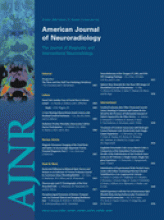OtherNeurointervention
Saccular Aneurysms on Straight and Curved Vessels Are Subject to Different Hemodynamics: Implications of Intravascular Stenting
H. Meng, Z. Wang, M. Kim, R.D. Ecker and L.N. Hopkins
American Journal of Neuroradiology October 2006, 27 (9) 1861-1865;
H. Meng
Z. Wang
M. Kim
R.D. Ecker

References
- ↵Stehbens WE. Pathology and pathogenesis of intracranial berry aneurysms. Neurol Res 1990;12:29–34
- ↵Weir B. Unruptured intracranial aneurysms: a review. J Neurosurg 2002;96:3–42
- ↵Geremia G, Haklin M, Brennecke L. Embolization of experimentally created aneurysms with intravascular stent devices. AJNR Am J Neuroradiol 1994;15:1223–31
- ↵Wakhloo AK, Schellhammer F, de Vries J, et al. Self-expanding and balloon-expandable stents in the treatment of carotid aneurysms: an experimental study in a canine model. AJNR Am J Neuroradiol 1994;15:493–502
- ↵Cloft HJ, Altes TA, Marx WF, et al. Endovascular creation of an in vivo bifurcation aneurysm model in rabbits. Radiology 1999;213:223–28
- ↵
- ↵
- ↵Niimi H, Kawano Y, Sugiyama I. Structure of blood flow through a curved vessel with an aneurysm. Biorheology 1984;21:603–15
- ↵Liepsch DW, Steiger HJ, Poll A, et al. Hemodynamic stress in lateral saccular aneurysms. Biorheology 1987;24:689–710
- ↵Danturthi R, Partridge LD, Turitto VT. Hemodynamics of intracranial lateral aneurysms: flow simulation studies. Proceedings of the 16th Southern Biomedical Engineering Conference. Biloxi, Mississippi, April1997 :224–27
- ↵Hoi Y, Meng H, Woodward SH, et al. Effects of arterial geometry on aneurysm growth: three-dimensional computational fluid dynamics study. J Neurosurg 2004;101:676–81
- ↵Lanzino G, Wakhloo AK, Fessler RD, et al. Efficacy and current limitations of intravascular stents for intracranial internal carotid, vertebral, and basilar artery aneurysms. J Neurosurg 1999;91:538–46
- Lylyk P, Cohen JE, Ceratto R, et al. Endovascular reconstruction of intracranial arteries by stent placement and combined techniques. J Neurosurg 2002;97:1306–13
- Rhee K, Han MH, Cha SH. Changes of flow characteristics by stenting in aneurysm models: influence of aneurysm geometry and stent porosity. Ann Biomed Eng 2002;30:894–904
- Lieber BB, Gounis MJ. The physics of endoluminal stenting in the treatment of cerebrovascular aneurysms. Neurol Res 2002;24(suppl 1):S33–42
- Ohta M, Hirabayashi M, Wetzel S, et al. Impact of stent design on intra-aneurysmal flow. Intervent Neuroradiol 2004;10:85–94
- ↵
- ↵Glagov S. Intimal hyperplasia, vascular modeling, and the restenosis problem. Circulation 1994;89:2888–91
- ↵Abruzzo T, Shengelaia GG, Dawson RC 3rd, et al. Histologic and morphologic comparison of experimental aneurysms with human intracranial aneurysms. AJNR Am J Neuroradiol 1998;19:1309–14
- ↵
- ↵Shin YS, Niimi Y, Yoshino Y, et al. Creation of four experimental aneurysms with different hemodynamics in one dog. AJNR Am J Neuroradiol 2005;26:1764–67
In this issue
Advertisement
H. Meng, Z. Wang, M. Kim, R.D. Ecker, L.N. Hopkins
Saccular Aneurysms on Straight and Curved Vessels Are Subject to Different Hemodynamics: Implications of Intravascular Stenting
American Journal of Neuroradiology Oct 2006, 27 (9) 1861-1865;
0 Responses
Jump to section
Related Articles
- No related articles found.
Cited By...
- Correlation of Flow Diverter Malapposition at the Aneurysm Neck with Incomplete Aneurysm Occlusion in Patients with Small Intracranial Aneurysms: A Single-Center Experience
- Predictors of unfavorable outcome in stent-assisted coiling for symptomatic unruptured intracranial spontaneous vertebral artery dissecting aneurysms (uis-VADAs): results from a multicenter study
- Rabbit Elastase Aneurysm Model Mimics the Recurrence Rate of Human Intracranial Aneurysms following Platinum Coil Embolization
- Parent Artery Straightening after Flow-Diverter Stenting Improves the Odds of Aneurysm Occlusion
- Hemodynamic differences between Pipeline and coil-adjunctive intracranial stents
- From bench to bedside: utility of the rabbit elastase aneurysm model in preclinical studies of intracranial aneurysm treatment
- Parent Artery Curvature Influences Inflow Zone Location of Unruptured Sidewall Internal Carotid Artery Aneurysms
- High WSS or Low WSS? Complex Interactions of Hemodynamics with Intracranial Aneurysm Initiation, Growth, and Rupture: Toward a Unifying Hypothesis
- Computational Hemodynamics Analysis of Intracranial Aneurysms Treated with Flow Diverters: Correlation with Clinical Outcomes
- Flow diversion to treat aneurysms: the free segment of stent
- The Varying Porosity of Braided Self-Expanding Stents and Flow Diverters: An Experimental Study
- Vascular Geometry Change Because of Endovascular Stent Placement for Anterior Communicating Artery Aneurysms
- Aneurysm Ostium Angle: A Predictor of the Need for Stent as Assistance for Endovascular Aneurysm Coiling in Internal Carotid Artery Sidewall Aneurysms
- Flow Diversion for Intracranial Aneurysms: A Review
- Clinical and Angiographic Follow-Up of Stent-Only Therapy for Acute Intracranial Vertebrobasilar Dissecting Aneurysms
- Asymmetric Vascular Stent: Feasibility Study of a New Low-Porosity Patch-Containing Stent
This article has not yet been cited by articles in journals that are participating in Crossref Cited-by Linking.
More in this TOC Section
Similar Articles
Advertisement











